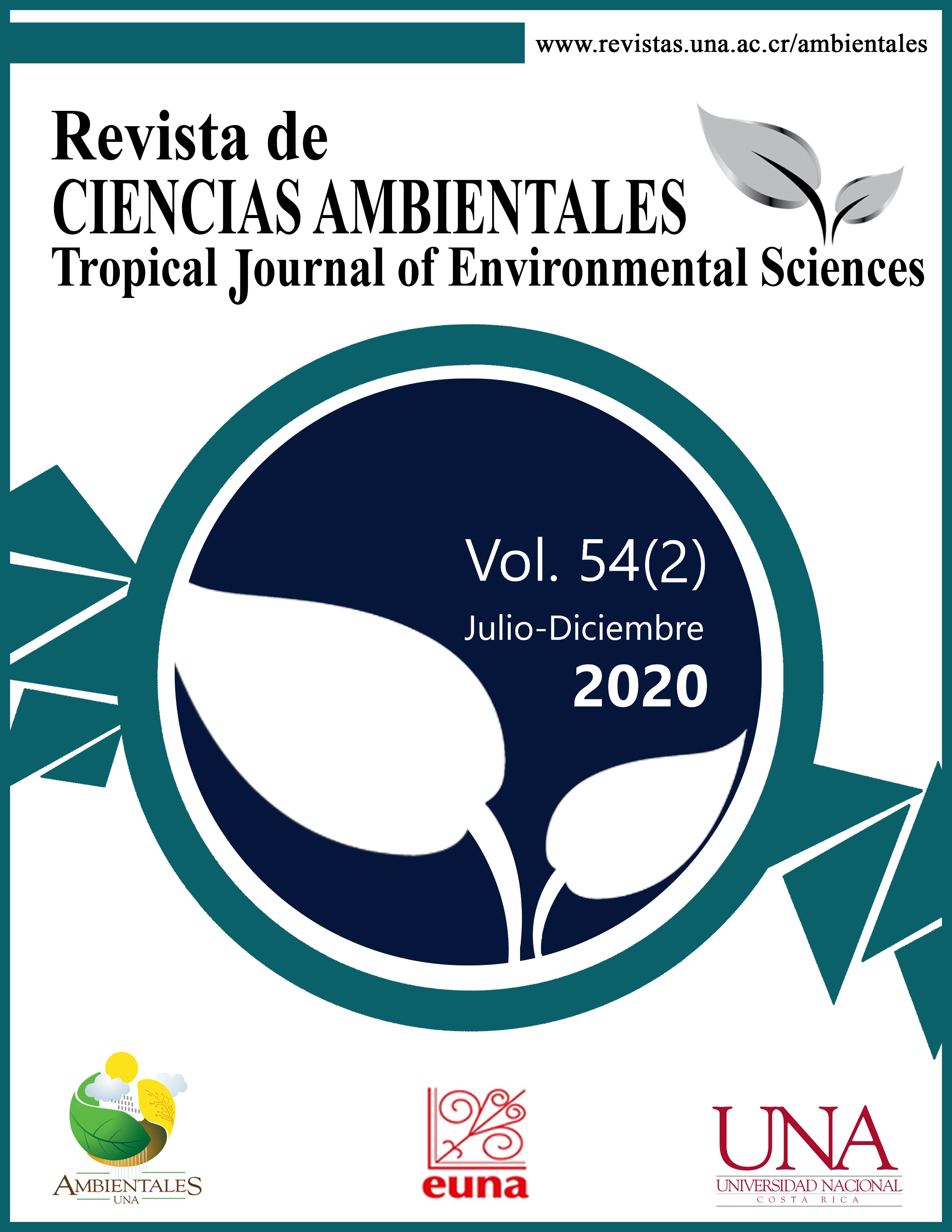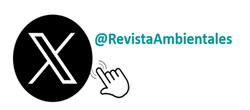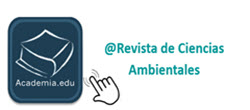In Search of a Preventive Approach to Management of the Meliaceas Borer (Hypsipyla grandella)
DOI:
https://doi.org/10.15359/rca.54-2.13Keywords:
biocontrol; bioinsecticides; Grafting; lateral shade; phagodeterrents; pheromones; repellents; risk prediction.Abstract
This paper summarizes the author and collaborators’ research experiences in the search for preventative methods to deal with Hypsipyla grandella (Lepidoptera: Pyralidae). Based upon the paradigm of integrated pest management (IPM), they include graftings of Cedrela odorata on a resistant rootstock of Australian cedar (Toona ciliata var. australis), the structuration of ecologically-robust plantations, based on plant diversification and natural biological control, the design of a risk prediction system, early population abatement through pheromone-baited traps, avoidance by adult repellence or larval deterrence, and larval mortality due to toxicity or growth disruption.
References
Arguedas, M., Hilje, L., Cartín, V., Calvo, M. A. y Borbón, H. (2018). Fagodisuasión de extractos de Brugmansia candida (Solanaceae) en larvas de Hypsipyla grandella (Lepidoptera: Pyralidae). Revista de Biología Tropical, 66(1), 58-69. https://doi.org/10.15517/rbt.v66i1.27466
Barboza, J., Hilje, L., Durón, J., Cartín, V. y Calvo, M. (2010a). Fagodisuasión de un extracto de ruda (Ruta chalepensis, Rutaceae) y sus particiones sobre larvas de Hypsipyla grandella (Lepidoptera: Pyralidae). Revista de Biología Tropical, 58(1), 1-14. https://doi.org/10.15517/rbt.v58i1.5190
Barboza, J., Hilje, L., Durón, J., Cartín, V. y Calvo, M. (2010b). Actividad fagodisuasiva y sistémica de una formulación derivada de un extracto de ruda (Ruta chalepensis, Rutaceae) sobre larvas de Hypsipyla grandella (Lepidoptera: Pyralidae). Revista de Biología Tropical, 58(1), 15-29. https://doi.org/10.15517/rbt.v58i1.5191
Becker, V. O. (1976). Microlepidópteros asociados con Carapa, Cedrela y Swietenia en Costa Rica. En J. L. Whitmore (Ed.), Studies on the shootborer Hypsipyla grandella (Zeller). Lep. Pyralidae (pp. 75-101, Miscellaneous Publication, 2(101) IICA.
Blassioli-Moraes, M. C., Borges, M., Laumann, R. A., Borges, R., Rodrigues Viana, A., Thomazini, M. J., Alves Silva, C. C., Morais de Oliveira, M. W. y Carissimi Boff, M. I. (2017). Identification and field evaluation of a new blend of the sex pheromone of Hypsipyla grandella. Pesquisa Agropecuária Brasileira, 52(11), 977-986. https://doi.org/10.1590/s0100-204x2017001100003
Grijpma, P. (Ed.). (1973). Studies on the shootborer Hypsipyla grandella (Zeller) Lep., Pyralidae. Miscellaneous Publ., 1(101), 91. IICA.
Grijpma, P. y Gara, R. I. (1973). Studies on the shootborer Hypsipyla grandella (Zeller). I. Host selection behavior. En P. Grijpma (Ed.), Studies on the shootborer Hypsipyla grandella (Zeller). Lep. Pyralidae (pp. 26-33, Miscellaneous Publ., 1(101). IICA.
Grijpma, P. y Ramalho, R. (1973). Toona spp., posibles alternativas para el problema del barrenador Hypsipyla grandella de las Meliaceae en América Latina. En P. Grijpma (Ed.), Studies on the shootborer Hypsipyla grandella (Zeller). Lep. Pyralidae (pp. 3-17, Miscellaneous Publ., 1(101. IICA.
Grijpma P. y Roberts S. C. (1976). Biological and chemical screening for the basis of resistance of Toona ciliata M.J. Roem var. australis. En J. L. Whitmore (Ed.), Studies on the shootborer Hypsipyla grandella (Zeller). Lep. Pyralidae (pp. 102-109, Miscellaneous Publication, 2(101). IICA.
Hart, R. D. (Ed.). (1985). Conceptos básicos sobre agroecosistemas. CATIE.
Hilje, L. y Cornelius, J. (2001). ¿Es inmanejable Hypsipyla grandella como plaga forestal? Manejo Integrado de Plagas, 38 (Hoja técnica).
Hilje, L. (2005). Evaluación de sustancias puras de origen vegetal como repelentes del barrenador de las meliáceas (Hypsipyla grandella). Informe final. CATIE. Turrialba, Costa Rica.
Hilje, L., Oehlschlager, C. y Macías, J. (2004). Síntesis y evaluación de la feromona sexual de Hypsipyla grandella. Informe final. CATIE. Turrialba, Costa Rica.
Jiménez, Q. (2007). Monografía de la familia Meliaceae. En B. E. Hammel, M. H. Grayum, C. Herrera y N. Zamora (Eds.), Manual de las plantas de Costa Rica (p. 575-614, Vol. VI). Missouri Botanical Garden, Instituto Nacional de Biodiversidad, Museo Nacional de Costa Rica.
Lemes, P. G., Zanuncio, A. J. V., Oliveira, L. S., Matos, M. F., Leite, G. L. D., Soares, M. A., Zanuncio, J. C y De Assis Jr., S. L. (2019). Hypsipyla grandella (Lepidoptera: Pyralidae) boring Khaya ivorensis (Meliaceae) fruits and seeds in Brazil: First report. Florida Entomologist, 102(1), 266-269. https://doi.org/10.1653/024.102.0151
Macías, J. E. (2004). Bark beetles and mahogany shootborer: Semiochemical research in Latin America. En L. Hilje (Ed.), Proceedings Workshop on Semiochemicals and Microbial Antagonists: Their Role in Integrated Pest Management in Latin America (p. 35-38). CATIE-IFS-KSLA-MISTRA. CATIE, Turrialba, Costa Rica.
Mancebo, F., Hilje, L., Mora, G. A. y Salazar, R. (2000a). Efecto de extractos vegetales sobre larvas de Hypsipyla grandella. Manejo Integrado de Plagas, 55, 12-23. https://doi.org/10.1016/S0261-2194(01)00069-2
Mancebo, F., Hilje, L., Mora, G. A. y Salazar, R. (2000b). Antifeedant activity of Quassia amara (Simaroubaceae) extracts on Hypsipyla grandella (Lepidoptera: Pyralidae) larvae. Crop Protection, 19(5), 301-305.
Mancebo, F., Hilje, L., Mora, G. A. y Salazar, R. (2002). Biological activity of two neem (Azadirachta indica A. Juss., Meliaceae) products on Hypsipyla grandella (Lepidoptera: Pyralidae) larvae. Crop Protection, 21, 107-112.
Mancebo, F., Hilje, L., Mora, G. A., Castro, V. H. y Salazar, R. (2001). Biological activity of Ruta chalepensis (Rutaceae) and Sechium pittieri (Cucurbitaceae) extracts on Hypsipyla grandella (Lepidoptera: Pyralidae) larvae. Revista de Biología Tropical, 49(2), 501-508.
Mexzón, R. G. y Chinchilla, C. M. (1997). Plant species attractive to beneficial entomofauna in oil palm (Elaeis guineensis Jacq.) plantations in Costa Rica. ASD Oil Palm Papers, 19, 1-39.
Navarro, C., Montagnini, F. y Hernández, G. (2004). Genetic variability of Cedrela odorata Linnaeus: Results of early performance of provenances and families from Mesoamerica grown in association with coffee. Forest Ecology and Management, 192, 217-227. https://doi.org/10.1016/j.foreco.2004.01.037
Pérez, J., Eigenbrode, S., Hilje, L., Tripepi, R., Aguilar, M. E. y Mesén, F. (2010a). Leaves from grafted Meliaceae species affect survival and performance of Hypsipyla grandella (Zeller) (Lepidoptera: Pyralidae) larvae. Journal of Pest Science, 83, 95-104. https://doi.org/10.1007/s10340-009-0275-8
Pérez, J., Eigenbrode, S., Hilje, L., Tripepi, R., Aguilar, M. E. y Mesén, F. (2010b). Use of grafting to prevent Hypsipyla grandella (Zeller) (Lepidoptera: Pyralidae) damage to New World Meliaceae species. Neotropical Entomology, 39(4), 618-625. https://doi.org/10.1590/S1519-566X2010000400024
Pérez, J., Eigenbrode, S. y Hilje, L. (2012). Alkaloids, limonoids and phenols from Meliaceae species decrease survival and performance of Hypsipyla grandella larvae. American Journal of Plant Sciences, 3, 988-994. https://doi.org/10.4236/ajps.2012.37117
Pineda-Ríos, J. M., Cibrián, J., Macías, J., Salomé, L. F., López, R. M. y Arjona Suárez, E. J. (2016). The composition and proportions of the Hypsipyla grandella Zeller (Lepidoptera: Pyralidae) sex pheromone varies depending on the isolation technique. Entomotropica, 31(21), 172-185.
Pinto, I. (2003). Evaluación de la repelencia de sustancias puras y de la atracción de combinaciones binarias de compuestos feromonales de Hypsipyla grandella (Zeller), en Costa Rica [Tesis Magister Scientiae]. CATIE. Turrialba, Costa Rica.
Soto, F., Hilje, L., Mora, G. A., Aguilar, M. E. y Carballo, M. (2007). Systemic activity of plant extracts in Cedrela odorata (Meliaceae) seedlings and their biological activity on Hypsipyla grandella (Lepidoptera: Pyralidae) larvae. Agriculture and Forest Entomology, 9, 221-226. https://doi.org/10.1111/j.1461-9563.2007.00338.x
Soto, F., Hilje, L., Mora, G. A. y Carballo, M. M. (2011). Phagodeterrence by Quassia amara (Simaroubaceae) wood extract fractions on Hypsipyla grandella (Lepidoptera: Pyralidae) larvae. Revista de Biología Tropical, 59(1), 487-499. https://doi.org/10.15517/rbt.v59i1.3215
Taveras, R., Hilje, L. y Carballo, M. (2004a). Development of Hypsipyla grandella (Lepidoptera: Pyralidae) in response to constant temperatures. Neotropical Entomology, 33(1), 1-6. https://doi.org/10.1590/S1519-566X2004000100002
Taveras, R., Hilje, L., Hanson, P., Mexzón, R., Carballo, M. y Navarro, C. (2004b). Population trends and damage patterns of Hypsipyla grandella (Lepidoptera: Pyralidae) in a mahogany stand, in Turrialba, Costa Rica. Agriculture and Forest Entomology, 6, 89-98. https://doi.org/10.1111/j.1461-9555.2004.00205.x
Varón, E. H., Barbera, N., Hanson, P., Carballo, M. y Hilje, L. (2005). Potencial de depredación de Hypsipyla grandella por hormigas, en cafetales de Costa Rica. Manejo Integrado de Plagas y Agroecología, 74, 17-23.
Whitmore, J. L. (Ed.). (1976a). Studies on the shootborer Hypsipyla grandella (Zeller). Lep., Pyralidae. Miscellaneous Publ., 2(101), 139. IICA.
Whitmore, J. L. (ed.). (1976b). Studies on the shootborer Hypsipyla grandella (Zeller). Lep., Pyralidae. Miscellaneous Publ., 3(101), 116. IICA
Zanetti, R., Abreu, C. S., Silveira, S. H. P y Andrade, E. D. (2017). First report of Hypsipyla grandella (Lepidoptera: Pyralidae) on African mahogany Khaya ivorensis. Scientia Agricola, 74(6), 492-494. https://doi.org/10.1590/1678-992x-2016-0362
Downloads
Published
How to Cite
Issue
Section
License

This work is licensed under a Creative Commons Attribution-NonCommercial-ShareAlike 4.0 International License.



















